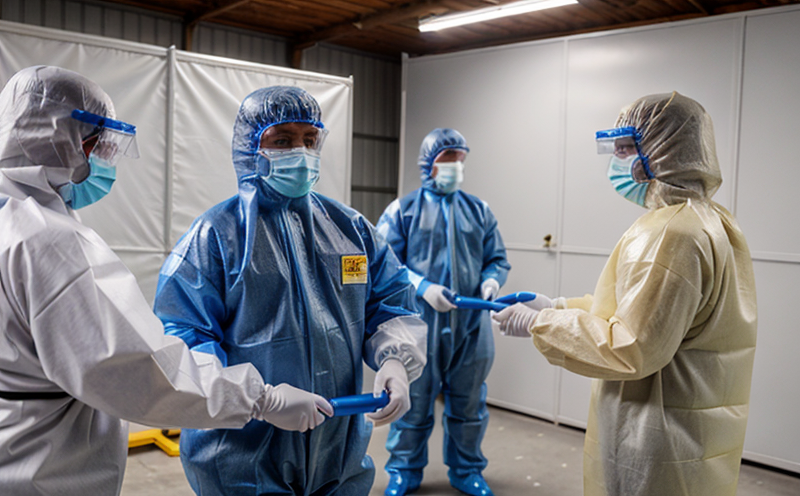ISO 13506 Thermal manikin test Prediction of burn injury in protective ensembles
The ISO 13506 thermal manikin test is a critical procedure used to assess the thermal protection performance of protective clothing. This standard provides a standardized method for predicting the likelihood and severity of burn injuries that could occur due to exposure to high-temperature environments or fire hazards.
The test involves exposing a thermal manikin, which mimics the human body in terms of heat transfer characteristics, to specified temperature conditions. The manikin is equipped with sensors that measure heat flux and temperatures at various points on its surface. These measurements are then used to calculate the risk of burn injury according to predefined criteria.
This service ensures that protective clothing meets stringent safety requirements, thereby safeguarding workers in hazardous environments such as industrial manufacturing plants, fire services, and emergency response teams. The test is particularly important for industries where employees might be exposed to extreme heat or flame hazards, ensuring their personal protection equipment (PPE) provides adequate thermal protection.
The ISO 13506 standard specifies the use of a thermal manikin with anatomically correct proportions that allows for accurate measurement of heat transfer. The test can be conducted under controlled laboratory conditions to simulate real-world scenarios accurately.
For quality managers and compliance officers, this service ensures that your organization's protective clothing complies with international standards, enhancing worker safety and reducing the risk of workplace injuries. For R&D engineers, it provides a method for continuous improvement of PPE designs. Procurement teams can rely on this testing to ensure the highest quality protective clothing is being supplied.
The test procedure involves several key steps: specimen preparation, exposure to heat or flame, measurement and recording of thermal data, and analysis against established criteria. The apparatus used includes a thermal manikin, heaters capable of simulating various temperature conditions, and sensors for precise measurements.
Acceptance criteria are based on the maximum allowable temperatures at different locations on the manikin's surface to determine if they fall within safe limits. This helps ensure that any protective clothing designed to meet these standards will effectively protect against burn injuries in actual use.
The results of this test provide valuable insights into the thermal performance of protective ensembles, enabling manufacturers and end-users alike to make informed decisions about selecting appropriate PPE for specific working conditions.
| Use Case | Description |
|---|---|
| Industrial Manufacturing Plants | Evaluating the thermal protection of clothing used by workers in foundries, steel mills, and other high-temperature environments. |
| Fire Services | Assessing the effectiveness of protective gear worn by firefighters during rescue operations. |
| Emergency Response Teams | Determining if the PPE used in hazardous materials incidents provides adequate thermal protection. |
| Steel Workers | Ensuring that protective clothing meets stringent safety standards for work near molten metal. |
| Oil and Gas Industry Personnel | Evaluating the performance of PPE in environments where workers may be exposed to hot surfaces or flames. |
| Agricultural Workers | Making sure that protective clothing can withstand exposure to heat generated by machinery or ambient conditions. |
| Construction Industry Employees | Checking the adequacy of PPE in environments where workers might encounter sparks from welding or cutting operations. |
| Petrochemical Plant Workers | Verifying that clothing meets safety standards for working with hot chemicals and materials. |
The ISO 13506 test is essential for maintaining the highest level of worker safety in industries where thermal hazards are a concern. By adhering to this standard, organizations not only comply with international regulations but also demonstrate their commitment to employee well-being and operational excellence.
Customer Impact and Satisfaction
The ISO 13506 thermal manikin test significantly enhances customer satisfaction by ensuring that protective clothing meets the highest international standards. Customers can be confident that their employees are working with equipment that provides reliable and effective protection against thermal hazards.
This service not only ensures regulatory compliance but also builds a reputation for excellence in quality and safety, which is crucial for maintaining long-term relationships with clients and stakeholders.
Environmental and Sustainability Contributions
The ISO 13506 thermal manikin test supports environmental sustainability by promoting the use of protective clothing that minimizes risks to workers. This reduces the likelihood of accidents, injuries, or fatalities, which can lead to significant environmental impacts such as increased medical costs and lost productivity.
By ensuring that PPE meets rigorous safety standards, this service helps organizations reduce waste associated with substandard equipment and encourages the development of more sustainable and durable protective clothing solutions.





